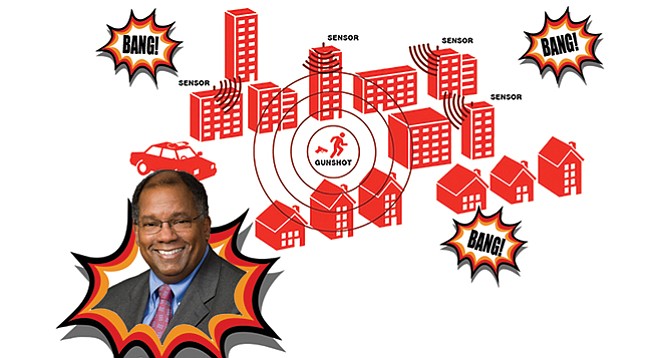 Facebook
Facebook
 X
X
 Instagram
Instagram
 TikTok
TikTok
 Youtube
Youtube

Those scary noises heard around the University of California San Diego last week were just the first shots in another advance of the surveillance state, according to a June 15 memo meant to reassure campus denizens about the shadowy disruptions. “On Monday, June 19 the UC San Diego Police Department will conduct a series of carefully-controlled tests for a newly installed gunshot detection and location system on the UC San Diego campus,” wrote vice chancellor Gary Matthews.
“Live ammunition will be used in a safe and controlled manner to ensure the system is functioning properly. Approximately 18 gunshots will be fired at each test site. You may hear these shots depending on your location.” Added the notice, “Appropriate safety and security measures will be used at each test site to ensure there is absolutely no danger to the public. These measures include use of bullet traps, which are designed to safely collect and store all bullets fired into them. All tests will be conducted by sworn police officers of the UC San Diego Police department.”
Noted Matthews, “Once we ensure the system is functioning as planned, the technology will enhance security for the UC San Diego campus, enabling a more rapid response in the event gunshots are ever fired on campus.” Per an online note by campus police, the system, from an outfit called ShotSpotter, will “capture data and a recorded audio file and then send it to the company’s incident-review centers. Acoustic experts review the data and add extra information such as whether it was multiple shooters or a high-capacity weapon. An alert, which contains map and location information, is sent to emergency dispatch and other authorities in a matter of seconds. This real-time element is crucial and can help save lives.”
When the technology was deployed last year by the City of San Diego in poorer parts of town, including the neighborhoods of Encanto, Skyline, Paradise Hills, and O’Farrell, critics complained installation had been done on the QT. “Why was it so secretive?” resident Kenneth Malbrough told KNSD-TV. “Why didn’t you want to have these discussions? Why not garner support from the community on this?” But San Diego cops were adamant about keeping the project covert, to the point of temporarily halting its implementation.
“The city engineer put a stop to the installation because they wanted ShotSpotter to open an SDGE account before moving forward,” says an in-house police memo obtained by the television station. “As you know if ShotSpotter were to open an account with SDGE it would reveal the sensor locations.” The secrecy has caused some to question ShotSpotter’s repeated reassurances that “The entire system is intentionally designed not to permit ‘live listening’ of any sort. Human voices do not trigger ShotSpotter sensors.”


Those scary noises heard around the University of California San Diego last week were just the first shots in another advance of the surveillance state, according to a June 15 memo meant to reassure campus denizens about the shadowy disruptions. “On Monday, June 19 the UC San Diego Police Department will conduct a series of carefully-controlled tests for a newly installed gunshot detection and location system on the UC San Diego campus,” wrote vice chancellor Gary Matthews.
“Live ammunition will be used in a safe and controlled manner to ensure the system is functioning properly. Approximately 18 gunshots will be fired at each test site. You may hear these shots depending on your location.” Added the notice, “Appropriate safety and security measures will be used at each test site to ensure there is absolutely no danger to the public. These measures include use of bullet traps, which are designed to safely collect and store all bullets fired into them. All tests will be conducted by sworn police officers of the UC San Diego Police department.”
Noted Matthews, “Once we ensure the system is functioning as planned, the technology will enhance security for the UC San Diego campus, enabling a more rapid response in the event gunshots are ever fired on campus.” Per an online note by campus police, the system, from an outfit called ShotSpotter, will “capture data and a recorded audio file and then send it to the company’s incident-review centers. Acoustic experts review the data and add extra information such as whether it was multiple shooters or a high-capacity weapon. An alert, which contains map and location information, is sent to emergency dispatch and other authorities in a matter of seconds. This real-time element is crucial and can help save lives.”
When the technology was deployed last year by the City of San Diego in poorer parts of town, including the neighborhoods of Encanto, Skyline, Paradise Hills, and O’Farrell, critics complained installation had been done on the QT. “Why was it so secretive?” resident Kenneth Malbrough told KNSD-TV. “Why didn’t you want to have these discussions? Why not garner support from the community on this?” But San Diego cops were adamant about keeping the project covert, to the point of temporarily halting its implementation.
“The city engineer put a stop to the installation because they wanted ShotSpotter to open an SDGE account before moving forward,” says an in-house police memo obtained by the television station. “As you know if ShotSpotter were to open an account with SDGE it would reveal the sensor locations.” The secrecy has caused some to question ShotSpotter’s repeated reassurances that “The entire system is intentionally designed not to permit ‘live listening’ of any sort. Human voices do not trigger ShotSpotter sensors.”
Comments